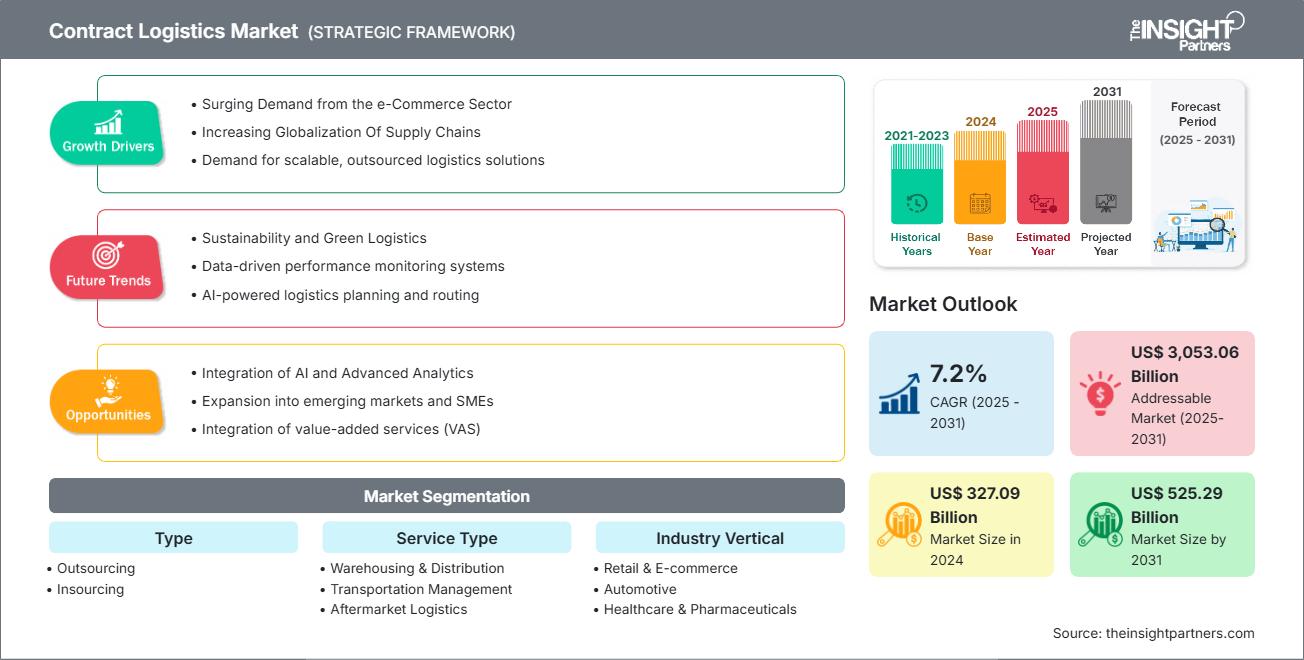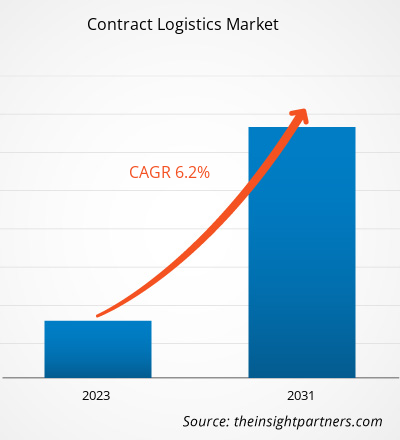계약 물류 시장 규모는 2024년 3,270억 9,000만 달러에서 2031년 5,252억 9,000만 달러로 성장할 것으로 예상됩니다. 이 시장은 2025년부터 2031년까지 7.2%의 CAGR을 기록할 것으로 예상됩니다.
계약 물류 시장 분석
계약 물류 시장은 전자상거래의 급속한 성장, 효율적인 공급망 솔루션에 대한 수요 증가, 그리고 정교한 물류 네트워크를 필요로 하는 무역의 세계화 등 몇 가지 주요 요인에 의해 성장하고 있습니다. 자동화, IoT, AI와 같은 기술 발전은 물류 운영의 가시성, 속도, 정확성을 향상시켜 상당한 성장 기회를 창출합니다. 또한, 기업들이 지속가능성에 점점 더 집중함에 따라 물류 업체들은 친환경 이니셔티브를 도입하고 시장 잠재력을 확대하고 있습니다.
계약 물류 시장 개요
계약 물류는 고객을 대신하여 창고, 운송, 재고 관리 및 유통을 관리하는 제3자 공급업체에 물류 및 공급망 관리 서비스를 아웃소싱하는 것을 의미합니다. 이러한 방식을 통해 기업은 핵심 역량에 집중하는 동시에 비용 효율성, 확장성 향상, 그리고 첨단 물류 기술 및 전문 지식 활용의 이점을 누릴 수 있습니다. 계약 물류는 소매, 제조, 자동차, 제약 및 전자상거래 분야에서 주문 이행, 화물 운송, 역물류 및 재고 관리에 널리 활용됩니다. 계약 물류 서비스의 유형은 단순 운송 및 창고 솔루션부터 포장, 조립 및 맞춤형 유통과 같은 부가가치 서비스를 포함한 통합 엔드 투 엔드 공급망 관리까지 다양합니다.
이 보고서의 일부 또는 국가 수준 분석, Excel 데이터 팩을 포함하여 모든 보고서에 대한 사용자 정의를 무료로 받을 수 있으며, 신생 기업 및 대학을 위한 훌륭한 혜택과 할인도 이용할 수 있습니다.
계약 물류 시장: 전략적 통찰력

- 이 보고서에서 주요 시장 동향을 알아보세요.이 무료 샘플에는 시장 동향부터 추정치 및 예측까지 다양한 데이터 분석이 포함됩니다.
계약 물류 시장 동인 및 기회
시장 동인:
전자상거래 부문의 수요 급증:
전자상거래의 급속한 확장은 계약 물류 시장의 성장을 크게 촉진하고 있습니다. 점점 더 많은 소비자가 온라인 쇼핑으로 전환함에 따라 기업들은 더 빠르고 효율적인 배송 및 주문 처리 서비스에 대한 수요 증가에 직면하고 있습니다. 이러한 급증으로 인해 기업들은 공급망, 창고 관리, 운송 및 최종 배송 관리를 전문으로 하는 제3자 공급업체에 물류 운영을 아웃소싱하게 되었습니다. 전 세계적으로 전자상거래가 확대되고 있습니다. 예를 들어, 2023년 인도 전자상거래 시장은 상당한 발전을 이루었습니다. 디지털 상거래를 위한 개방형 네트워크(ONDC)는 11월 디왈리 주간에 약 120만 건의 거래를 기록하며 디지털 상거래 활동의 급증을 보여주었습니다. 2023년 12월까지 ONDC는 한 달 동안 550만 건의 거래를 달성했으며, 이 중 210만 건은 소매 부문에서 발생하여 디지털 플랫폼 도입이 증가하고 있음을 보여주었습니다.ONDC) recorded nearly 1.2 million transactions during Diwali week in November, reflecting a surge in digital commerce activities. By December 2023, ONDC achieved 5.5 million transactions in a month, with 2.1 million in the retail category, indicating a growing adoption of digital platforms.
공급망의 글로벌화 증가:
공급망의 세계화 확대는 계약 물류 시장 성장을 촉진하는 핵심 요인입니다. 기업들이 여러 국가에서 원자재를 조달하고 제품을 생산하는 경우가 증가함에 따라, 이러한 분산된 운영을 관리하는 복잡성이 크게 증가하고 있습니다. 이처럼 글로벌 시장 간의 상호 연결성이 커짐에 따라 더욱 효율적이고 유연하며 전문적인 물류 솔루션이 요구되고 있습니다. 계약 물류 제공업체는 기업이 국제 운송, 세관 규정, 그리고 다양한 유통망과 관련된 과제를 해결하는 데 중요한 역할을 합니다. 2023년 6월, 미국 상무부는 공급망 경쟁력 자문위원회(ACSCC)를 설립하여 관계 당국과 업계 리더들을 한자리에 모아 국경 간 물류, 조달 다각화, 그리고 인프라 격차에 대한 공조를 논의했습니다. 이러한 모든 요소는 아웃소싱 물류 역량에 대한 의존도를 높이는 중요한 요인입니다.ACSCC), bringing together officials and industry leaders to discuss coordination on cross-border logistics, diversification of sourcing, and infrastructure gaps—all critical factors amplifying reliance on outsourced logistics capacity.
시장 기회:
지속 가능성 및 녹색 물류:
지속가능성과 친환경 물류는 공급망 운영을 환경 및 사회 거버넌스(ESG) 목표에 맞춰 조정함으로써 계약 물류 시장에 상당한 기회를 창출합니다. 전 세계 기업들이 탄소 발자국을 줄이고 환경적으로 책임 있는 관행을 도입해야 한다는 압력이 커짐에 따라, 계약 물류 제공업체들은 운영 효율성을 향상시키면서 환경에 미치는 영향을 줄이는 혁신적인 솔루션을 개발하고 있습니다. 이러한 친환경 물류 전략은 배출량 최소화, 운송 경로 간소화, 창고 에너지 효율 개선, 재생 에너지원 통합에 중점을 둡니다. 이러한 관행을 채택함으로써 기업은 글로벌 지속가능성 목표 달성에 기여하고 장기적인 회복탄력성과 경쟁력을 강화할 수 있습니다.
계약 물류 시장 보고서 세분화 분석
계약 물류 시장은 구조, 성장 전망, 그리고 새로운 트렌드에 대한 포괄적인 이해를 제공하기 위해 여러 부문으로 분류됩니다. 대부분의 업계 보고서에서 사용되는 표준 세분화 방식은 다음과 같습니다.
유형별:
아웃소싱:
계약 물류 아웃소싱은 기업이 창고, 운송, 재고 관리 , 주문 처리 등 공급망 및 물류 운영을 제3자 물류(3PL) 업체에 위임하는 것을 의미합니다. 이 부문은 2024년 계약 물류 시장 점유율 1위를 차지했습니다.인소싱:
계약 물류의 인소싱은 기존에 아웃소싱되었던 물류 운영을 다시 사내로 이전하여 관리, 효율성, 그리고 서비스 맞춤화를 개선하는 것을 의미합니다. 글로벌 공급망의 혼란 속에서 기업들이 더 큰 유연성을 추구함에 따라 이러한 추세는 더욱 확산되고 있습니다.
서비스 유형별:
창고 및 유통:
창고 및 유통은 계약 물류의 핵심 요소로, 기업은 효율적인 재고 관리와 적시 제품 이동을 통해 공급망을 간소화할 수 있습니다. 이 부문은 2024년 계약 물류 시장 점유율 1위를 차지했습니다.
교통 관리:
운송 관리(Transportation Management)는 계약 물류의 핵심 요소로, 공급망 전반에 걸쳐 상품의 효율적이고 시기적절하며 비용 효율적인 이동을 보장합니다. 여기에는 경로 계획, 운송업체 선정, 화물 감사, 선적 추적 및 성과 최적화가 포함됩니다.애프터마켓 물류:
계약 물류 분야의 애프터마켓 물류는 초기 제품 판매 후 예비 부품, 반품, 수리, 재활용 또는 재생과 관련된 이동, 관리 및 가치 증대에 중점을 둡니다.기타:
계약 물류 시장에서 다른 서비스 범주에는 포장, 라벨링, 화물 운송과 같은 중요한 부가가치 솔루션이 포함됩니다.
산업별 수직별:
- 소매 및 전자 상거래
- 자동차
- 헬스케어 및 제약
- 소비재 및 전자제품
- 산업 및 제조
- 항공우주 및 방위
- 기타
지리별:
- 북아메리카
- 유럽
- 아시아 태평양
- 남미 및 중미
- 중동 및 아프리카
아시아 태평양 지역의 계약 물류 시장은 가장 빠른 성장을 보일 것으로 예상됩니다. 국경 간 전자상거래 부문의 성장이 이러한 성장을 주도하고 있습니다.
계약 물류 시장 지역별 통찰력
The Insight Partners의 분석가들은 예측 기간 동안 계약 물류 시장에 영향을 미치는 지역별 동향과 요인을 면밀히 분석했습니다. 이 섹션에서는 북미, 유럽, 아시아 태평양, 중동 및 아프리카, 그리고 중남미 지역의 계약 물류 시장 부문과 지역별 현황도 살펴봅니다.
계약 물류 시장 보고서 범위
| 보고서 속성 | 세부 |
|---|---|
| 2024년 시장 규모 | 3,270억 9천만 달러 |
| 2031년까지 시장 규모 | 5,252억 9천만 달러 |
| 글로벌 CAGR(2025~2031년) | 7.2% |
| 역사적 데이터 | 2021-2023 |
| 예측 기간 | 2025-2031 |
| 다루는 세그먼트 | 유형별
|
| 포함된 지역 및 국가 | 북아메리카
|
| 시장 선도 기업 및 주요 회사 프로필 |
|
계약 물류 시장 참여자 밀도: 비즈니스 역학에 미치는 영향 이해
계약 물류 시장은 소비자 선호도 변화, 기술 발전, 그리고 제품 이점에 대한 인식 제고 등의 요인으로 인한 최종 사용자 수요 증가에 힘입어 빠르게 성장하고 있습니다. 수요 증가에 따라 기업들은 제품 및 서비스를 확장하고, 소비자 니즈를 충족하기 위한 혁신을 추진하며, 새로운 트렌드를 적극 활용하고 있으며, 이는 시장 성장을 더욱 가속화하고 있습니다.

- 계약 물류 시장의 주요 기업 개요를 확인하세요
지역별 계약 물류 시장 점유율 분석
아시아 태평양 지역은 향후 몇 년 동안 가장 빠른 성장을 보일 것으로 예상됩니다. 중남미, 중동 및 아프리카의 신흥 시장 또한 계약 물류 제공업체가 확장할 수 있는 많은 미개척 기회를 보유하고 있습니다.
전자상거래 산업의 성장과 다양한 국가 간 무역 증가로 인해 계약 물류 시장은 지역별로 다르게 성장하고 있습니다. 아래는 지역별 시장 점유율과 동향을 요약한 것입니다.
1. 북미
시장 점유율:
글로벌 시장의 상당 부분을 차지합니다주요 동인:
- 급속한 온라인 소매 확장으로 인해 효율적인 이행과 마지막 단계 물류가 요구됩니다.
- 자동화, 로봇공학, 창고 관리 시스템의 통합.
- 기업들은 핵심 사업 운영에 집중하기 위해 물류를 점점 더 아웃소싱하고 있습니다.
트렌드:
종단 간 공급망 가시성과 민첩성을 위한 3PL 및 4PL 파트너십의 증가.
2. 유럽
시장 점유율:
EU의 엄격한 조기 규제로 인해 상당한 점유율 확보주요 동인:
- 여러 국가에 걸쳐 조율되고 규정을 준수하는 물류에 대한 높은 수요.
- 배출량을 줄이고 친환경 물류 솔루션을 도입하라는 압력.
- 특수 물류 서비스에 대한 수요가 높습니다.
트렌드:
운송 차량의 전기화 및 창고에서의 지속 가능한 포장재 사용.
3. 아시아 태평양
시장 점유율:
지배적인 시장 점유율을 가진 가장 빠르게 성장하는 지역주요 동인:
- 높은 생산량에는 확장 가능한 물류 솔루션이 필요합니다.
- 특히 인도, 중국, 동남아시아에서 전자상거래 생태계가 성장하고 있습니다.
- 항구, 고속도로, 물류단지에 대한 대규모 투자.
트렌드:
하이브리드 소매 모델을 지원하기 위한 옴니채널 물류에 대한 수요 급증.
4. 중동 및 아프리카
시장 점유율:
작지만 빠르게 성장하고 있습니다주요 동인:
- 소매, 의료 등 비석유 부문의 물류 수요 증가.
- UAE, 사우디아라비아, 이집트 등 지역 허브의 성장.
- 글로벌 물류 기업을 유치하기 위해 규정을 간소화합니다.
트렌드:
대형 프로젝트(예: NEOM, DP World 확장)에 맞춰 물류 허브가 등장합니다.
5. 남미 및 중미
시장 점유율:
꾸준한 성장으로 성장하는 시장주요 동인:
- 메르코수르와 태평양 동맹 국가에서 지역 내 상거래가 증가했습니다.
- 콜드체인 물류에 대한 수요.
- 도시화와 소매업의 성장.
트렌드:
모바일 플랫폼과 차량 추적 시스템을 통해 물류의 디지털화가 확대되었습니다.
계약 물류 시장 참여자 밀도: 비즈니스 역학에 미치는 영향 이해
높은 시장 밀도와 경쟁
DHL Supply Chain, XPO Logistics, DB Schenker, Kuehne + Nagel과 같은 주요 글로벌 기업들의 진출로 경쟁이 치열해지고 있습니다. 또한 FedEx(북미), CEVA Logistics(프랑스), Nippon Express(일본)와 같은 지역 특화 운송업체들이 등장하면서 경쟁 환경이 더욱 다각화되고 있습니다.
이러한 높은 수준의 경쟁으로 인해 기업은 다음과 같은 서비스를 제공하여 두각을 나타내야 합니다.
- 통합 공급망 솔루션(예: 창고, 최종 배송, 재고 관리)
- 창고 운영을 위한 자동화 및 로봇 기술에 대한 투자
- 특정 분야 전문성 개발(예: 제약, 자동차, 전자상거래)
- IoT, AI, 실시간 가시성 플랫폼 등 첨단 기술의 구축
기회와 전략적 움직임
- 창고 및 재고 관리에 AI, IoT 및 자동화를 구현하면 효율성이 향상되고 인적 오류가 줄어듭니다.
- 데이터 분석과 머신 러닝은 수요 예측, 네트워크 최적화, 예측 유지 관리에 활용됩니다.
계약 물류 시장에서 운영되는 주요 회사는 다음과 같습니다.
- Deutsche Post AG(독일)
- FedEx Corp(미국)
- GXO Logistics Inc. (미국)
- 유나이티드 파슬 서비스 주식회사(미국)
- 닛폰 익스프레스 주식회사(일본)
- GEODIS SA(프랑스)
- 라이더 시스템 주식회사(미국)
- CMA CGM SA(프랑스)
- DSV AS(덴마크)
- Kuehne + Nagel International AG (스위스)
면책 조항: 위에 나열된 회사는 특정 순서에 따라 순위가 매겨지지 않았습니다.
연구 과정에서 분석된 다른 회사:
- 익스피디터스 인터내셔널
- CH 로빈슨 월드와이드
- 레누스 로지스틱스
- 펜스케 로지스틱스
- 파이지 로지스틱
- 톨 글로벌 로지스틱스
- APL 로지스틱스
- GAC(걸프 에이전시 회사)
- 유센 로지스틱스
- 볼로레 로지스틱스
- SF 홀딩(SF 익스프레스)
- 다크서
- 라벤 그룹
- 화물 파트너
- 안드레아니 그루포
- 창고 서비스 주식회사
- NFI
- 리니지 로지스틱스
- TVS 공급망 솔루션
- 아라멕스
- 톨 그룹
- 델리베리
- 글로벌트랜즈
- 게브뤼더 바이스
- CMA CGM(계약 물류 부문)
- MSC(지중해 해운 회사)
- 윈캔턴 주식회사
- CJ대한통운
계약 물류 시장 뉴스 및 최근 동향
DHL 그룹은 2025년 4월 Temu와 양해각서(MoU)에 서명했습니다.
DHL 그룹은 이커머스 마켓플레이스 테무(Temu)와 협력을 강화하고 성공적인 파트너십을 확대하기 위한 양해각서(MoU)를 체결했습니다. 이번 협약은 기존 시장뿐만 아니라 동유럽 및 중동과 같은 성장 시장의 지역 중소기업(SME)을 더욱 효과적으로 지원하기 위한 협력 강화를 목표로 합니다.GXO Logistics, Inc.는 2025년 4월 Revelyst와의 파트너십을 확대합니다.
세계 최대 순수 계약 물류 기업인 GXO Logistics, Inc.(NYSE: GXO)는 아웃도어 활동에 필요한 고성능 장비와 정밀 기술을 디자인 및 제조하는 브랜드들의 연합체인 Revelyst와의 파트너십을 갱신하고 확대한다고 발표했습니다. GXO는 아인트호벤 창고에서 피킹, 포장, 반품 관리를 포함한 B2B 및 B2C 물류 서비스를 계속 운영할 예정입니다.
계약 물류 시장 보고서 범위 및 제공물
"계약 물류 시장 규모 및 예측(2021~2031)" 보고서는 아래 영역을 포괄하여 시장에 대한 자세한 분석을 제공합니다.
- 범위에 포함된 모든 주요 시장 부문에 대한 글로벌, 지역 및 국가 수준의 계약 물류 시장 규모 및 예측
- 계약 물류 시장 동향 및 동인, 제약, 주요 기회와 같은 시장 역학
- 자세한 PEST 및 SWOT 분석
- 주요 시장 동향, 글로벌 및 지역 프레임워크, 주요 참여자, 규정 및 최근 시장 개발을 포괄하는 계약 물류 시장 분석
- 시장 집중도, 히트맵 분석, 주요 업체 및 계약 물류 시장의 최근 동향을 다루는 산업 환경 및 경쟁 분석
- 자세한 회사 프로필
- 과거 분석(2년), 기준 연도, CAGR을 포함한 예측(7년)
- PEST 및 SWOT 분석
- 시장 규모 가치/거래량 - 글로벌, 지역, 국가
- 산업 및 경쟁 환경
- Excel 데이터세트
최근 보고서
관련 보고서
사용 후기
구매 이유
- 정보에 기반한 의사 결정
- 시장 역학 이해
- 경쟁 분석
- 고객 인사이트
- 시장 예측
- 위험 완화
- 전략 기획
- 투자 타당성 분석
- 신흥 시장 파악
- 마케팅 전략 강화
- 운영 효율성 향상
- 규제 동향에 발맞춰 대응




















 무료 샘플 받기 - 계약 물류 시장
무료 샘플 받기 - 계약 물류 시장